Wow that was close!
NASA, the European Space Agency (ESA) and the Indian Space Research Organization (ISRO) are reporting that their Mars Orbiters are safe and doing fine after comet C/2013 A1 Siding Spring brushed by and made its closest approach to the Red Planet Sunday, with its nucleus passing by at approximately 1827 UTC.
Scientists said that the comet blew past Mars at a speed of about 56 kilometers per second and got as close as 139,500 kilometers of the planet, that’s about one-third of the distance between Earth and the Moon.
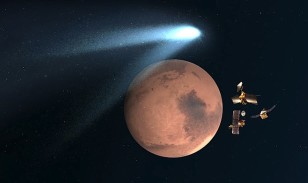
Artist’s concept shows the NASA Mars orbiters lining up behind Mars for their “duck and cover” maneuver to shield them from comet dust that may result from the close flyby of Comet 2013 A1 Siding Spring on Oct. 19, 2014. (NASA/JPL/Caltech)
All three space agencies put special measures in place ahead of time to protect their spacecraft from the envelope of gas and high-velocity dust particles that accompanies the comet in its orbital trip around the sun.
NASA moved its Mars Odyssey, Mars Reconnaissance Orbiter and the Mars Atmosphere and Volatile Evolution (MAVEN) to the opposite side of the planet from the approaching comet.
Officials with each of the three NASA orbiter missions also took additional steps to protect their spacecraft and its onboard instruments.
ESA put its Mars Express into a special protective mode that would reduce any risk to the spacecraft from from comet particles.
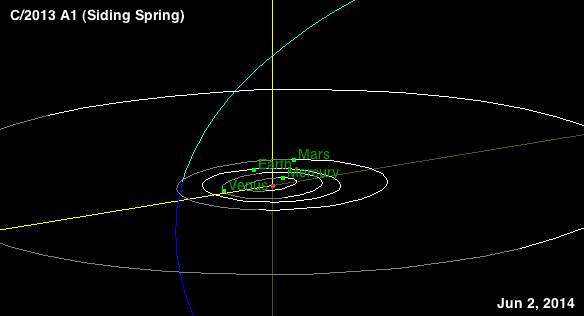
Path of Comet Siding Spring animation (NASA/JPL/Caltech)
“This included turning off all instruments and non-essential onboard systems, and turning the spacecraft so as to use the large high-gain antenna as a shield,” said Mars Express Spacecraft Operations Manager Michel Denis in a press release.
ISRO’s Mars Orbiter Mission Tweeted “Phew! Experience of a lifetime. Watched the #MarsComet #SidingSpring whizzing past the planet. I’m in my orbit, safe and sound.”
The fleet of spacecraft also had a ring-side seat to watch the rare celestial event as the comet zipped past Mars.
The space agencies said that their orbiters are sending images and observational data back to Earth where it’s being downloaded. NASA said that it could take days for it to retrieve a full download of data from its spacecraft.
To get a wide range of observations of the Comet’s close encounter with Mars, NASA used other resources, such as its Mars rovers Curiosity and Opportunity, as well as other spacecraft and facilities like the Hubble, Swift and Kepler Space Telescopes to watch the flyby from their unique perspectives.
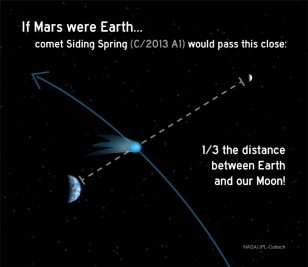
If Mars were Earth, comet Siding Spring would pass by at about 1/3 the distance of Earth to the Moon. (NASA/JPL/Caltech)
Comet C/2013 A1 Siding Spring was discovered by astronomer Robert McNaught at Australia’s Siding Spring Observatory on January 3, 2013. At the time of its discovery the comet was about 1,078,260,480 km from the sun.
Scientists said that the celestial object originated in the ‘Oort Cloud’ and probably has been making its orbital trip toward the sun for millions of years.
The comet is expected to reach its perihelion – closest encounter with the Sun – on October 25, 2014 getting within a distance of 1.39875 AU or 209,250,022 km.
After rendezvousing with the sun, Comet C/2013 A1 Siding Spring will make its long return trip back into the depths of the solar system way beyond Pluto.

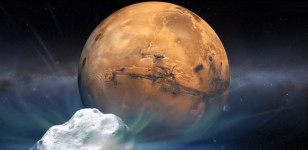
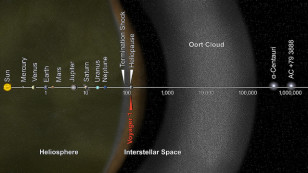




















Comments are closed.